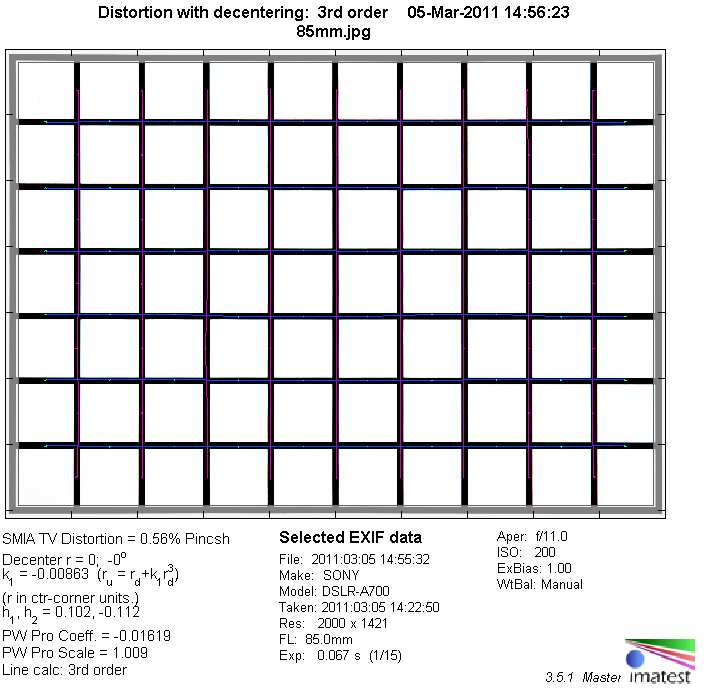|
Sony 85mm f/2.8 SAM ( SAL-85F28 ) - APS-C Format Review / Lab Test - Analysis |
|
Lens Reviews -
Sony Alpha/NEX (APS-C)
|
|
Page 2 of 2

Distortion
The Sony lens produces a very slight amount of pincushion distortion (~0.5%). This is not relevant in field conditions anymore.

Vignetting
The 85mm f/2.8 is a full format lens and when used on an APS-C DLSR with its smaller image circle the vignetting is relatively insignificant. We're talking about a light falloff of just ~0.4EV at max. aperture which is already barely detectable anymore by the human standards.

MTF (resolution)
The Sony lens is capable of delivering an extremely high resolution on an APS-C DSLR. The performance is already excellent across the image field straight at f/2.8 and the contrast level is also very snappy here. The quality increases only very marginally at f/4 and diffraction has an impact from f/5.6 onwards. However, the quality is still very good at f/11. The field curvature is marginal.
Please note that the MTF results are not directly comparable across the different systems!
Below is a simplified summary of the formal findings. The chart shows line widths per picture height (LW/PH) which can be taken as a measure for sharpness.
If you want to know more about the MTF50 figures you may check out the corresponding Imatest Explanations
Chromatic Aberrations (CAs)
Lateral chromatic aberrations (color shadows at harsh contrast transitions) vary between 0.5px at f/2.8 and ~0.7px at f/11. This is quite low and not overly field-relevant.

Bokeh
The quality of the bokeh (rendering of the out-of-focus blur) is very decent. Out-of-focus highlights have an smooth inner zone with only very slight outlining. The highlight discs have a circular shape at f/2.8 and there's only a very marginal hint of the edgy aperture shape at f/4 here.
 The out-of-focus background (see the left-hand sample crop below) is rendered smoothly whereas the foreground (to the right) is a little nervous.
The out-of-focus background (see the left-hand sample crop below) is rendered smoothly whereas the foreground (to the right) is a little nervous.

Bokeh Fringing / Longitudinal Chromatic Aberrations (LoCA)
Bokeh fringing is a common problem among large aperture lenses. At max. aperture you may be able to spot purple halos in front and green halos beyond the focus point. The issue does gradually improve when stopping down but there're still visible traces at f/4, less so at f/5.6.
|
Move the mouse cursor over the f-stop marks below to observe the respective LoCAs
|
| f/2.8 |
f/4 |
f/5.6 |
|

|
Verdict
The Sony 85mm f/2.8 SAM ( SAL-85F28 ) is an impressive lens when used on APS-C DSLRs - at least with respect to its optical capabilities. The lens is extremely sharp across the frame from f/2.8 to f/8. Diffraction is a limiting factor beyond. Lateral CAs are quite low which adds to the subjective quality perception. The lens produces only a very slight amount of pincushion distortion. Thanks to its full-format design there's almost no vignetting to speak of on APS-C DSLRs even at max. aperture. The quality of the bokeh is good. LoCAs/Bokeh fringing can be visible at f/2.8 and the issues dissolves gradually when stopping down. A weakness is a tendency towards purple fringing at max. aperture.
The Sony 85mm f/2.8 SAM is a budget lens and it's most obvious in its build quality - the body is made of rather average quality plastics down to the mount. The new build-in SAM drive is an improvement over the conventional screw-driven AF. The AF accuracy seems to have improved quite a bit but we haven't really noticed a significant advantage in terms of AF speed or noise. However, that all said the Sony lens remains a killer offer in terms of value-for-money.
|